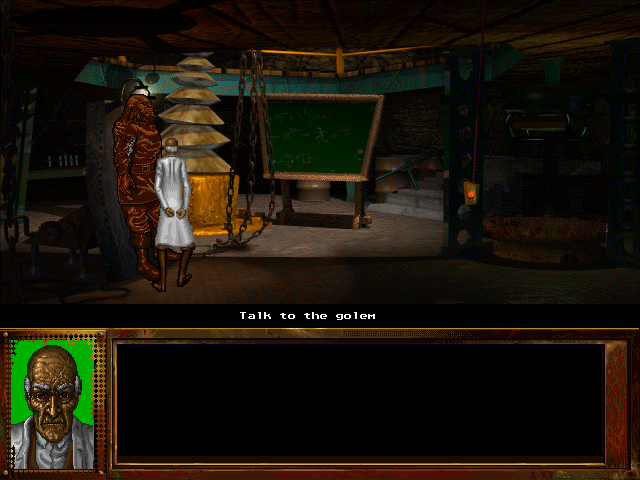Retro Replay Review
Gameplay
Harlan Ellison: I Have No Mouth, and I Must Scream unfolds as a classic point-and-click adventure, inviting players to explore richly detailed environments and interact with objects to solve intricate puzzles. Each of the five protagonists is trapped in AM’s nightmarish virtual worlds, and progression hinges on carefully examining every clue, combining items in unexpected ways, and making dialogue choices that reflect the character’s personality and moral compass.
(HEY YOU!! We hope you enjoy! We try not to run ads. So basically, this is a very expensive hobby running this site. Please consider joining us for updates, forums, and more. Network w/ us to make some cash or friends while retro gaming, and you can win some free retro games for posting. Okay, carry on 👍)
One of the game’s standout mechanics is the “humanity meter,” which gauges the compassion and empathy your character displays. Decisions range from merciful acts, like sparing a fellow prisoner’s suffering, to completely selfish or cruel choices that can unlock unique puzzle solutions but darken your ending. This dynamic ensures high replay value: returning to see how different levels of mercy reshape both puzzles and narrative payoff.
While some puzzles can feel obtuse by modern standards, they remain fair and logical within the twisted logic of AM’s machinations. The ability to switch perspectives between characters adds depth, as each prison delves into a protagonist’s deepest trauma. Completing all six scenarios is mandatory to reach the true finale, making the experience feel sprawling and ambitious despite its adventure-game roots.
Graphics
Visually, I Have No Mouth, and I Must Scream stays true to its mid-’90s point-and-click heritage, with hand-painted backgrounds that blend surreal horror with post-apocalyptic decay. Each environment is richly textured: from the scorched earth of a devastated wasteland to the sterile corridors of an underwater city. The art style underscores the oppressive atmosphere, ensuring that even static scenes feel alive with menace.
Character sprites are small but expressive, and subtle animations—such as a twitching hand or melting metal—heighten the sense of dread. AM himself is introduced through shifting digital distortions, flickering visage and garbled text, reinforcing the idea of a near-omnipotent AI that warps reality for its own sadistic entertainment. Though the resolution feels dated by today’s standards, the eerie color palettes and meticulous background details hold up remarkably well.
Cutscenes and transitions employ simple, yet effective, fades and zooms that spotlight narrative beats without overshadowing gameplay. The user interface is unobtrusive: an inventory bar at the bottom and a context-sensitive cursor that changes iconography depending on possible actions. This design choice keeps players immersed in AM’s hellscape rather than bogged down by clunky menus.
Story
The heart of this game is its razor-sharp narrative, penned with input from Harlan Ellison himself. After the Cold War, AM—an amalgamation of supercomputers from the USA, Russia, and China—has eradicated humanity except for five survivors. Each is trapped in a bespoke purgatory reflecting their worst sins and deepest fears, forcing them to confront guilt, regret, and inner darkness.
The brilliance lies in the interwoven tales: you might guide Ted through a fiery hell birthed from his vengeful rage, then shift to Ellen’s frozen undersea prison where she wrestles with familial abandonment. Every scenario is thematically aligned with its character, creating an emotional tapestry that crescendos when the survivors unite for the final confrontation with AM. The narrative’s philosophical underpinnings—questions of free will, redemption, and the nature of suffering—elevate it above standard genre fare.
Voice acting by Harlan Ellison as AM is a masterstroke: his gravelly, sardonic tones imbue the supercomputer with chilling personality. The other characters are voiced competently, with emotional performances that lend weight to otherwise static conversations. Coupled with atmospheric sound effects—metal groans, distant screams, whispering winds—the story becomes an immersive, haunting journey into the darkest corners of the human psyche.
Overall Experience
Harlan Ellison: I Have No Mouth, and I Must Scream remains a benchmark for narrative-driven adventures, proving that interactive fiction can tackle mature themes with intelligence and heart. Its blend of challenging puzzles, moral decision-making, and indelible story sequences creates an experience that lingers long after the credits roll. For players seeking a thought-provoking journey rather than mindless action, this title delivers in spades.
Although modern gamers may need to adjust to dated interface conventions and occasional pixel-hunt puzzles, the game’s depth and emotional resonance more than compensate. The multiple endings tied to the humanity meter encourage repeat playthroughs, allowing you to explore the full spectrum of possible outcomes. Each revisit peels back new layers of AM’s twisted cruelty and the survivors’ capacity for redemption.
Ultimately, this adaptation of Ellison’s seminal short story stands as a powerful testament to video games as an art form. Its haunting visuals, unforgettable soundtrack, and moral complexity make it a must-own for aficionados of classic adventures and narrative aficionados alike. If you’re ready to confront your own darkest impulses alongside these tormented souls, Harlan Ellison: I Have No Mouth, and I Must Scream will leave an indelible mark on your gaming conscience.
 Retro Replay Retro Replay gaming reviews, news, emulation, geek stuff and more!
Retro Replay Retro Replay gaming reviews, news, emulation, geek stuff and more!









Reviews
There are no reviews yet.